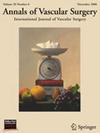将 "合并症-多药性评分 "作为慢性肢体缺血下肢血管重建术患者存活率和肢体挽救率的预测工具。
IF 1.4
4区 医学
Q3 PERIPHERAL VASCULAR DISEASE
引用次数: 0
摘要
目的:合并症-药物治疗评分(CPPS)是为评估老年病患者合并症的临床负担而设计的。它是在不同情况下对患者进行风险分层的客观工具。本研究旨在评估 CPPS 在预测接受择期血管重建手术的 CLTI 患者的死亡率和截肢率方面的作用:这是一项为期两年的回顾性单中心研究。方法:这是一项为期 2 年的回顾性单中心研究。我们纳入了所有接受择期下肢血管重建手术并确诊为 CLTI 的患者。定义了四组 CPPS:轻度、中度、重度和病态。早期和长期的主要结果分别是30天总死亡率、30天截肢率、总生存率和肢体挽救率:结果:共有 442 名患者参与研究。平均年龄为(76.5±9.9)岁,61.5%(272/442)为男性。计算出 CPPS:22.6%(100/442)为轻度 CPPS,54.3%(240/442)为中度,21.9%(97/442)为重度,1.2%(5/442)为病态。根据 CPPS 分级进行分层的总生存率 Kaplan-Meier 曲线显示出显著的统计学差异(p):CPPS 是评估患者复杂性的直接工具,可作为辅助工具对接受择期血管重建手术的 CLTI 患者的早期和长期预后进行分层。本文章由计算机程序翻译,如有差异,请以英文原文为准。
The Comorbidity-Polypharmacy Score as a Predictive Tool of Survival and Limb Salvage in Patients Undergoing Lower Limb Revascularization Procedures for Chronic Limb-Threatening Ischemia
Background
The comorbidity-polypharmacy score (CPPS) was created to evaluate the clinical burden of comorbidities in geriatric patients. It represents an objective tool to stratify patients’ risk in different settings. The study aimed to evaluate CPPS in predicting mortality and amputation in patients undergoing elective revascularization procedures in chronic limb-threatening ischemia (CLTI) patients.
Methods
This is a 2-year retrospective single-center study. We included all patients undergoing elective lower-limb revascularization procedures admitted with CLTI diagnosis. Four CPPS groups were defined: mild, moderate, severe, and morbid. The primary early and long-term outcomes were 30-day overall mortality, 30-day amputation rate, and overall survival and limb salvage, respectively.
Results
A total of 442 patients were enrolled in the study. Mean age was 76.5 ± 9.9 years, and 61.5% (272/442) were male. CPPS was calculated: 22.6% (100/442) have mild CPPS, 54.3% (240/442) moderate, 21.9% (97/442) severe, and 1.2% (5/442) morbid. Kaplan-Meier curves for overall survival stratified by CPPS grade highlighted a strong statistically significant difference (P < 0.0001) among the 4 CPPS classes. Mild CPPS has a significantly higher limb salvage rate among moderate, severe, and morbid CPPS groups (P < 0.0001). Limb salvage for mild and severe CPPS, at 36 months was 95% vs. 85.1%, respectively. Stepwise multivariable Cox-analysis revealed that mortality was independently associated with dialysis, Rutherford Classification V, age, and CPPS. Male sex, multilevel arterial disease, and hybrid surgical repair were independently associated with amputations.
Conclusions
CPPS is a straightforward tool to evaluate the patient's complexity and could be used as an adjuvant tool to stratify early- and long-term outcomes in CLTI patients undergoing elective revascularization procedures.
求助全文
通过发布文献求助,成功后即可免费获取论文全文。
去求助
来源期刊
CiteScore
3.00
自引率
13.30%
发文量
603
审稿时长
50 days
期刊介绍:
Annals of Vascular Surgery, published eight times a year, invites original manuscripts reporting clinical and experimental work in vascular surgery for peer review. Articles may be submitted for the following sections of the journal:
Clinical Research (reports of clinical series, new drug or medical device trials)
Basic Science Research (new investigations, experimental work)
Case Reports (reports on a limited series of patients)
General Reviews (scholarly review of the existing literature on a relevant topic)
Developments in Endovascular and Endoscopic Surgery
Selected Techniques (technical maneuvers)
Historical Notes (interesting vignettes from the early days of vascular surgery)
Editorials/Correspondence

 求助内容:
求助内容: 应助结果提醒方式:
应助结果提醒方式:


